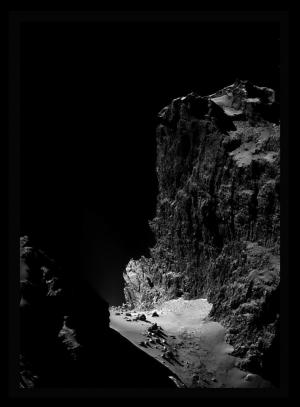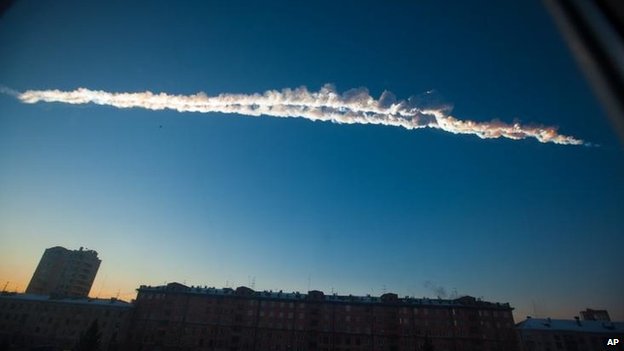At http://phys.org/print338024091.html … below is an image of cliffs on Comet Churyumov-Gerasimenko, processed by one Stuart Atkinson. The cliff is nearly verticle
 See also www.esa.int/Our_Activities/Space_Science/Rosetta/Comet_67P_Churyumov-Ger…
See also www.esa.int/Our_Activities/Space_Science/Rosetta/Comet_67P_Churyumov-Ger…
At http://phys.org/print337934945.html … below we have another image, this time it is of the Chelyabinsk meteor of 2013 seen leaving a trail in the sky over some houses
 The story, surprisingly, comes from The Conversation – which is patrolled by some strange bedfellows. However, it does not stick its neck out and avoids speculating about how often life threatening meteors and comets may have inter-acted with the people of the Earth in the past, and why would they, they do speculate on other planetary systems out there is deep space. It is of course safer to do that – and won't upset the patrol lobby. Other systems, they say, may have been bombarded to a greater degree than our solar system, containing lots more nasty asteroids and meteors. The idea, I think, is to reduce the number of possible exo-planets where life may exist – by deleting as many as possible down to manageable proportions. The theory is that life would have been wiped out by asteroids if there was a lot of debris floating around other star systems, using the extinction of the dinosaurs as an example. The problem with this kind of thinking is that although reptiles were wiped out those mammals that survived, possibly just a remnant of those that existed at the time, were able to evolve into a myriad different forms in order to fill the niche locations formerly held by others. In other words, catastrophic evolution thrives on asteroids and meteors, quite the opposite of the point they wish to make.
The story, surprisingly, comes from The Conversation – which is patrolled by some strange bedfellows. However, it does not stick its neck out and avoids speculating about how often life threatening meteors and comets may have inter-acted with the people of the Earth in the past, and why would they, they do speculate on other planetary systems out there is deep space. It is of course safer to do that – and won't upset the patrol lobby. Other systems, they say, may have been bombarded to a greater degree than our solar system, containing lots more nasty asteroids and meteors. The idea, I think, is to reduce the number of possible exo-planets where life may exist – by deleting as many as possible down to manageable proportions. The theory is that life would have been wiped out by asteroids if there was a lot of debris floating around other star systems, using the extinction of the dinosaurs as an example. The problem with this kind of thinking is that although reptiles were wiped out those mammals that survived, possibly just a remnant of those that existed at the time, were able to evolve into a myriad different forms in order to fill the niche locations formerly held by others. In other words, catastrophic evolution thrives on asteroids and meteors, quite the opposite of the point they wish to make.
